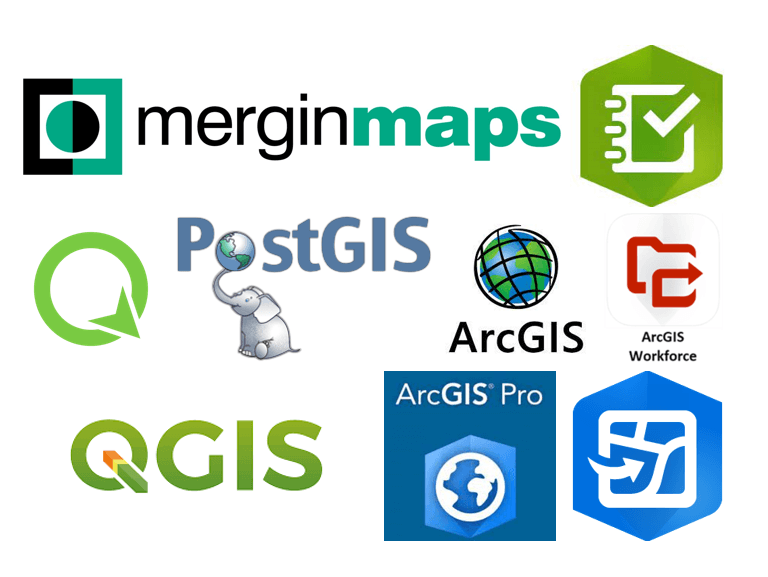Introduction to GIS
Geographic Information Systems (GIS) are powerful tools for managing, analyzing, and visualizing spatial data. They help us understand our world better by using two main types of data: vector and raster. Vector data represents discrete objects like roads and boundaries with points, lines, and polygons. For example, in the telecom industry, vector data can show the locations of cell towers and the routes of fiber optic cables. Raster data, on the other hand, captures continuous phenomena such as satellite imagery, elevation and temperature across areas. Telecom companies might use raster data to analyze signal coverage areas, basemaps during the planning, or to plan the placement of new infrastructure based on terrain using digital terrain models aquired with LIDAR equipment.
GIS is versatile, working on desktops for detailed analysis, on the web for easy data sharing, and on mobile devices for fieldwork. It integrates with other technologies like GNSS receivers, LIDAR and Remote Sensing, making it even more powerful. This integration helps automate tasks and improve efficiency. There are both proprietary and open-source SDKs available that enable the customization and development of tailor-made tools to meet the specific needs of companies. Spatial analysis, a core feature of GIS, assists in identifying patterns and facilitating decision-making. It is utilized across various fields, including telecommunications, to design network layouts, enhance services, and better comprehend customer requirements. In the upcoming blog post, we will explore some of the applications of GIS tools and discuss why they are crucial in planning FTTx (FTTH, FTTN, FTTC, FTTB, FTTD) networks.

Understanding the FTTx challenges
Deploying Fiber to the X (FTTx) networks comes with a wide range of challenges, from business decisions to technical setup. In one of our previous posts, we talked about the key steps for a successful FTTH rollout. Now, we’ll touch on some of these challenges to give you a clearer picture.

Business Challenges:
- Market Analysis: Understanding current and future bandwidth demands, along with customer profiling, is critical.
- Competition: Assessing competitors’ technology, coverage areas, and pricing strategies.
- Regulations: Navigating through local and national regulations that impact deployment.
Financial Planning and Cost Analysis:
- Capital Expenditure (CapEx) and Operational Expenditure (OpEx): Calculating initial investment and ongoing operational costs.
- Network Management Plans: Strategizing on the management and maintenance of the network.
- Area Responsibility: Identifying municipal and cadastral boundaries to understand jurisdictional responsibilities.
- Material and Construction Costs: Estimating the cost of materials and construction based on surface types and distances.
- Equipment and Workforce Availability: Ensuring the availability of necessary equipment and skilled labor for deployment.
Technical Challenges:
- Existing Infrastructure Routes: Integrating plans with the routes of existing infrastructure.
- New Infrastructure Planning: Utilizing up-to-date basemaps for accurate real-world mapping.
- Aerial Infrastructure Positions: Determining the placement of overhead infrastructure.
- Redundancy Planning: Strategic planning to ensure network reliability and redundancy.
- Cell Station Coverage: Ensuring that cell stations are adequately covered.
- Area Types and Topology: Choosing the best network topology and architecture for different area types.
- Greenfield vs. Existing Areas: Planning overlays between new developments and existing infrastructure.
- Network Analysis and Planning: Implementing clear symbology, attribute data, and equipment modeling for efficient network planning.
- Automated Routing: Using graph algorithms for automated routing in cost analysis or splicing plans.
- Connectivity Routes: Creating connectivity routes in both attribute and vector formats.
- Quick Service Provisioning: Streamlining the process of connecting new clients using various teams or outsourcing.
- Network Maintenance: Utilizing field tools for navigation, real-time visibility of network elements, and fast updates.
- Inter-departmental Communication: Facilitating easy communication between different departments through web GIS and desktop GIS.
- Workforce Planning: Employing spatial insights for efficient workforce deployment, such as assigning the closest team to outages.
- Real-time reporting and visualization transform data into interactive maps and charts, providing instant insights and updates on changes as they happen.
Understanding and addressing these challenges are crucial for the successful deployment and management of FTTx networks, highlighting the complexity and the need for comprehensive planning and execution strategies.
How GIS solves these challenges?
GIS is a game-changer for telecom companies, making everything from network planning to customer service smoother and more efficient. It pinpoints demand for new networks and optimizes connections, saving time and resources. For existing networks, GIS quickly identifies and resolves issues, often remotely, keeping services reliable and customers satisfied.
In marketing, GIS targets potential customers precisely, boosting the effectiveness of campaigns. It also provides a live network view for swift maintenance responses, enhancing reliability and customer happiness.
With the shift to cloud-based GIS, data sharing across departments becomes seamless. Real-time updates and access mean quicker decision-making and problem-solving, from the field to the office. GIS streamlines workflows, improving task allocation, data accuracy, and project speed.
Field teams benefit from GIS apps, collecting high-accuracy data on-the-go. This data, integrated with LIDAR and photogrammetry, offers detailed, real-time maps for planners. These insights enable efficient scheduling, construction monitoring, and even weather-based planning adjustments.
Back in the office, planners use standardized data and tools for clear, unified project visuals and analysis. They can automate planning tasks, ensuring fast and accurate infrastructure designs. Web GIS extends these capabilities to construction, maintenance, and sales, allowing for focused marketing strategies and operational oversight.
Our team is skilled in a wide range of technologies, from open-source to premium solutions like ArcGIS Pro, QGIS, and AutoCAD Map. We leverage spatial databases like PostgreSQL and PostGIS on various platforms, specializing in FTTx network design and management. We streamline the entire process, from field data collection to network planning and customer engagement, using web GIS for live updates and strategic decision-making.
In essence, GIS empowers telecom companies to plan more effectively, resolve issues swiftly, and deeply understand their markets through the strategic use of location data

Summary
GIS is transforming the telecom industry, enhancing efficiency across network planning, customer engagement, and service delivery. Here’s how:
Benefits of GIS for Telecom Companies:
- Optimized Network Planning: Identifies where new networks are needed and connects them efficiently, saving time and resources.
- Improved Service Reliability: Quickly fixes network issues, often remotely, ensuring stable and reliable services.
- Enhanced Marketing: Targets potential customers accurately, making marketing campaigns more effective.
- Streamlined Operations: Cloud-based GIS allows for seamless data sharing and real-time decision-making across departments.
Key Applications of GIS:
- Network Planning & Deployment: Pinpoints demand and optimizes connections for new and existing networks.
- Maintenance & Operations: Offers a live view of the network for quick issue resolution and maintenance planning.
- Marketing & Customer Service: Identifies customer locations and needs, improving campaign targeting and service delivery.
- Workflow Efficiency: Improves task allocation, data accuracy, and project speed through streamlined workflows.
Technological Edge with GIS:
- Field Data Collection: Utilizes GIS apps and external RTK GNSS receivers for high-accuracy, on-the-go data collection, integrated with LIDAR and photogrammetry.
- Office Planning & Design: Standardizes data and automates planning tasks for fast, accurate infrastructure designs with unified project visuals.
- Web GIS for Technical Departments and & Sales: Facilitates construction monitoring, maintenance oversight, and targeted marketing strategies with real-time operational insights.
Our Expertise:
Our team excels in a broad spectrum of technologies, covering everything from open-source to proprietary solutions. We are proficient in most common GIS and CAD tools, including ArcGIS Pro, ArcMap, QGIS, Mapinfo, Microstation, and AutoCAD Map. We specialize in FTTx network design and management, leveraging spatial databases like PostgreSQL and PostGIS on platforms like Azure and AWS, Python and FME scripts for automation. Our comprehensive approach streamlines the entire process from field data collection to network planning and customer engagement, supported by web GIS for strategic decision-making and live updates. If you need consultation or assistance, give us a call. We are always happy to chat about our passion.
In summary, GIS provides telecom companies with the tools to efficiently plan networks, solve problems quickly, and gain deep insights into their customer base through the strategic application of location data.
